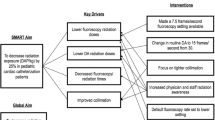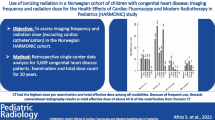Abstract
To stratify diverse procedure types into categories with similar radiation exposure in cardiac catheterization for congenital heart disease. Radiation exposures for a comprehensive list of specific procedure types and stratification of outcomes based on radiation risk are not currently available. Data between January 2014 and December 2015 were collected on all cases performed at sites participating in C3PO-QI (Congenital Cardiac Catheterization Outcomes Project-Quality Improvement Initiative) and 9 centers were included. Using expert consensus, 40 unique procedure types were defined by diagnostic characteristics or the intervention(s) performed, and dose area product (DAP) per kilogram of body weight (µGy × m2/kg) was summarized. Using empiric and consensus methods, three radiation risk categories were created. A total of 11,735 cases were included for analysis. Thirteen (n = 7918) procedure types with median DAP/kg < 100 were categorized in the low radiation exposure category (median DAP/kg 39). The medium exposure category (n = 1807) consisted of 16 procedure types with median DAP/kg values ranging 100 to < 200 (overall median DAP/kg 131). Finally, the high radiation exposure category (n = 1073) consisted of 11 procedure types with median DAP/kg ≥ 200 (overall median DAP/kg of 231). The radiation exposure risk categories created in this multi-center dataset are a critical step towards the development of a robust risk adjustment methodology for radiation exposure in catheterization for congenital heart disease.




Similar content being viewed by others
References
Verghese GR, McElhinney DB, Strauss KJ, Bergersen L (2012) Characterization of radiation exposure and effect of a radiation monitoring policy in a large volume pediatric cardiac catheterization lab. Catheter Cardiovasc Interv 79(2):294–301
Glatz AC, Patel A, Zhu X, Dori Y, Hanna BD, Gillespie MJ, Rome JJ (2014) Patient radiation exposure in a modern, large-volume, pediatric cardiac catheterization laboratory. Pediatr Cardiol 35(5):870–878
Martinez LC, Vano E, Gutierrez F, Rodriguez C, Gilarranz R, Manzanas MJ (2007) Patient doses from fluoroscopically guided cardiac procedures in pediatrics. Phys Med Biol 52(16):4749–4759
Ghelani SJ, Glatz AC, David S, Leahy R, Hirsch R, Armsby LB, Trucco SM, Holzer RJ, Bergersen LJ (2014) Radiation dose benchmarks during cardiac catheterization for congenital heart disease in the United States. JACC Cardiovasc Interv 7(9):1060–1069
Chida K, Ohno T, Kakizaki S, Takegawa M, Yuuki H, Nakada M, Takahashi S, Zuguchi M (2010) Radiation dose to the pediatric cardiac catheterization and intervention patient. Am J Roentgenol 195(5):1175–1179
El Sayed MH, Roushdy AM, El Farghaly H, El Sherbini A (2012) Radiation exposure in children during the current era of pediatric cardiac intervention. Pediatr Cardiol 33(1):27–35
Al-Haj AN, Lobriguito AM, Rafeh W (2008) Variation in radiation doses in paediatric cardiac catheterisation procedures. Radiat Prot Dosimetry 129(1–3):173–178
Dragusin O, Gewillig M, Desmet W, Smans K, Struelens L, Bosmans H (2008) Radiation dose survey in a paediatric cardiac catheterisation laboratory equipped with flat-panel detectors. Radiat Prot Dosimetry 129(1–3):91–95
Rassow J, Schmaltz AA, Hentrich F, Streffer C (2000) Effective doses to patients from paediatric cardiac catheterization. Br J Radiol 73(866):172–183
Cevallos PC, Armstrong AK, Glatz AC, Goldstein BH, Gudausky TM, Leahy RA, Petit CJ, Shahanavaz S, Trucco SM, Bergersen LJ (2017) Radiation dose benchmarks in pediatric cardiac catheterization: a prospective multi-center C3PO-QI study. Catheter Cardiovasc Interv 90(2):269–280
NAS/NRC (National Academy of Sciences/National Research Council) (2006) Health risks from exposure to low levels of ionizing radiation, BEIR VII, phase 2. National Academy Press, Washington DC, pp 1–423
Royal HD (2008) Effects of low level radiation—what’s new? Semin Nucl Med 38(5):392–402
Andreassi MG (2009) Radiation risk from pediatric cardiac catheterization: friendly fire on children with congenital heart disease. Circulation 120(19):1847–1849
Johnson JN, Hornik CP, Li JS, Benjamin DK, Yoshizumi TT, Reiman RE, Frush DP, Hill KD (2014) Cumulative radiation exposure and cancer risk estimation in children with heart disease. Circulation 130(2):161–167
Ait-Ali L, Andreassi MG, Foffa I, Spadoni I, Vano E, Picano E (2010) Cumulative patient effective dose and acute radiation-induced chromosomal DNA damage in children with congenital heart disease. Heart 96:269–274
Bacher K, Bogaert E, Lapere R, Wolf D, De, Thierens H (2005) Patient-specific dose and radiation risk estimation in pediatric cardiac catheterization. Circulation 111(1):83–89
Boothroyd A, McDonald E, Moores BM, Sluming V, Carty H (1997) Radiation exposure to children during cardiac catheterization. Br J Radiol 70(830):180–185
Martin EC, Olson A (1980) Radiation exposure to the paediatric patient from cardiac catheterization and angiocardiography. Br J Radiol 53(626):100–106
Hoffman JIE, Kaplan S, Liberthson RR (2004) Prevalence of congenital heart disease. Am Heart J 147(3):425–439
Hill KD, Frush DP, Han BK, Abbott BG, Armstrong AK, DeKemp RA, Glatz AC, Greenberg B, Herbert AS, Justino H, Mah D, Mahesh M, Rigsby CK, Slesnick TC, Strauss KJ, Trattner S, Viswanathan MN, Einstein AJ (2017) Radiation safety in children with congenital and acquired heart disease: a scientific position statement on multimodality dose optimization from the image gently alliance. J Am Coll Cardiol Cardiovasc Img 10(7):797–818. https://doi.org/10.1016/j.jcmg.2017.04.003
Onnasch DGW, Schröder FK, Fischer G, Kramer H-H (2007) Diagnostic reference levels and effective dose in paediatric cardiac catheterization. Br J Radiol 80(951):177–185
Acknowledgements
We appreciate support by a grant from The Children’s Heart Foundation.
Author information
Authors and Affiliations
Consortia
Contributions
All authors have read, reviewed, and approved of the manuscript.
Corresponding author
Ethics declarations
Conflicts of interest
All authors declare that they have no conflicts of interest to disclose.
Research involving human and animal participants
This article does not contain any studies with human participants or animals performed by any of the authors.
Rights and permissions
About this article
Cite this article
Quinn, B.P., Armstrong, A.K., Bauser-Heaton, H.D. et al. Radiation Risk Categories in Cardiac Catheterization for Congenital Heart Disease: A Tool to Aid in the Evaluation of Radiation Outcomes. Pediatr Cardiol 40, 445–453 (2019). https://doi.org/10.1007/s00246-018-2024-3
Received:
Accepted:
Published:
Issue Date:
DOI: https://doi.org/10.1007/s00246-018-2024-3




